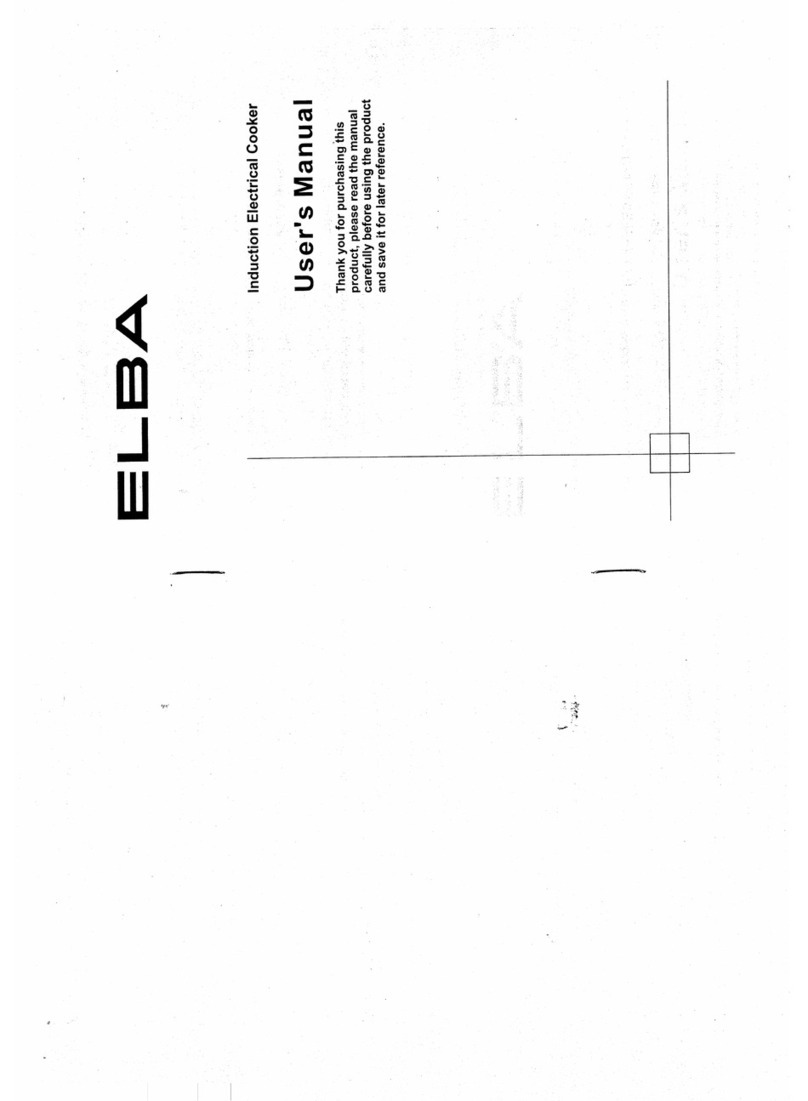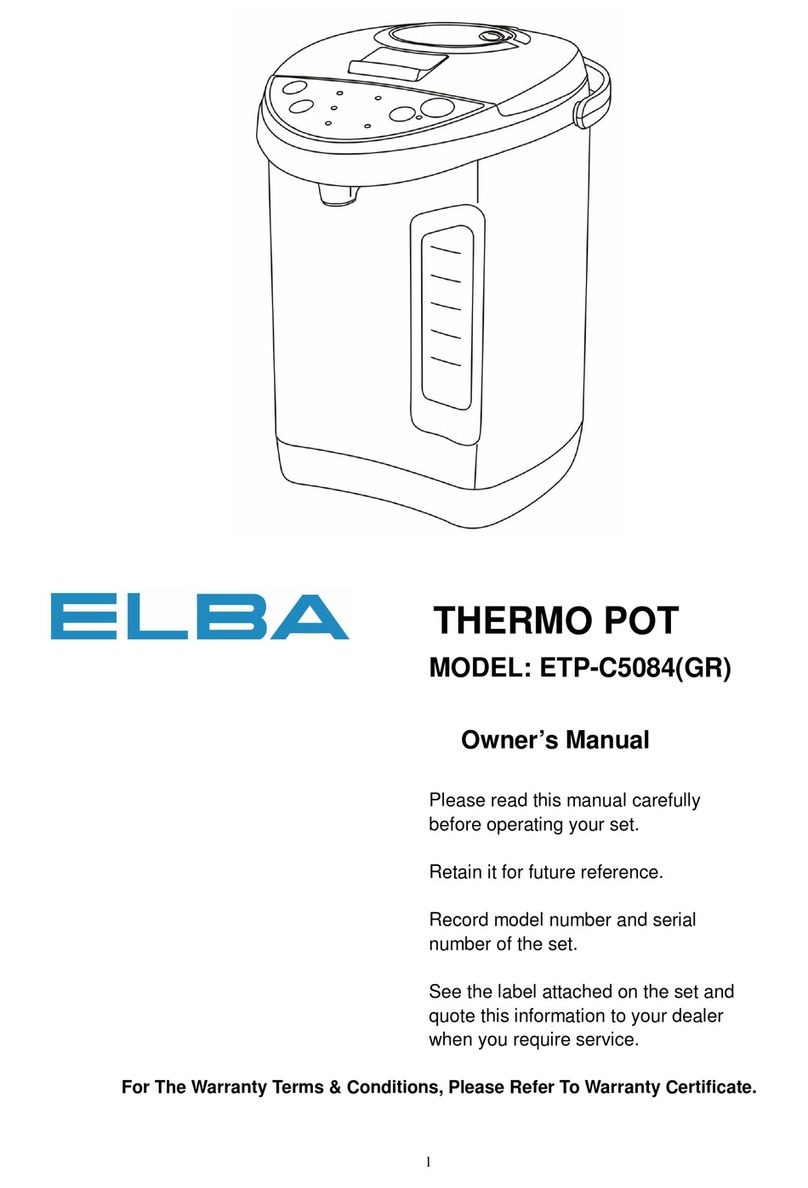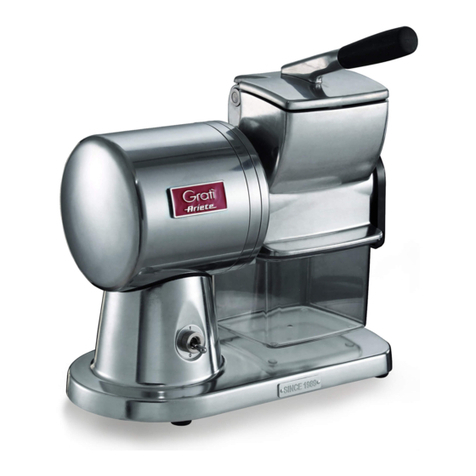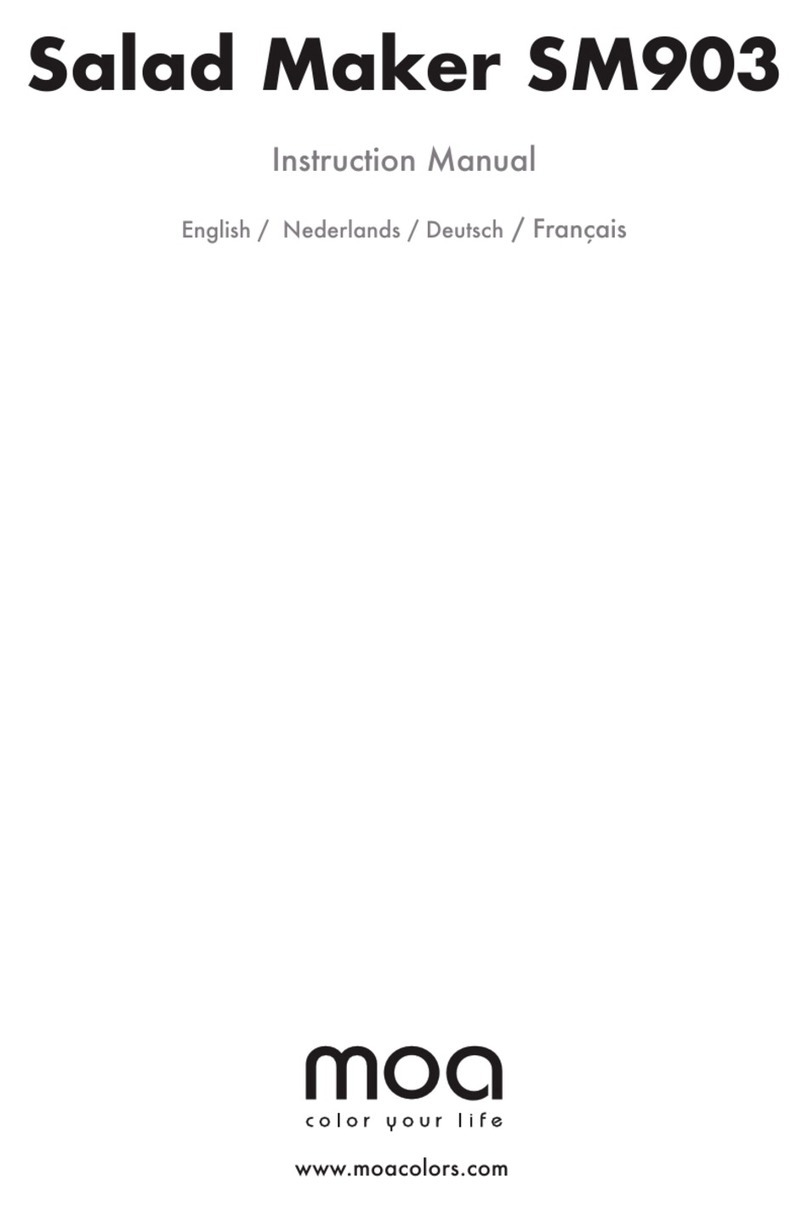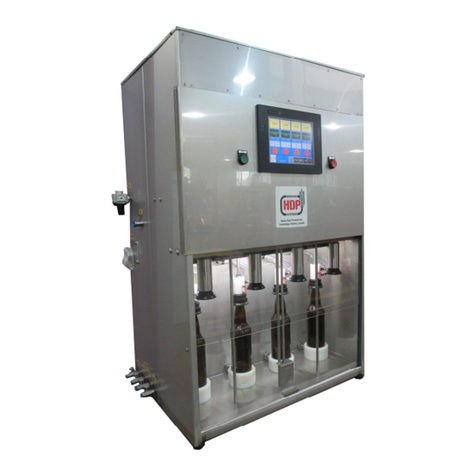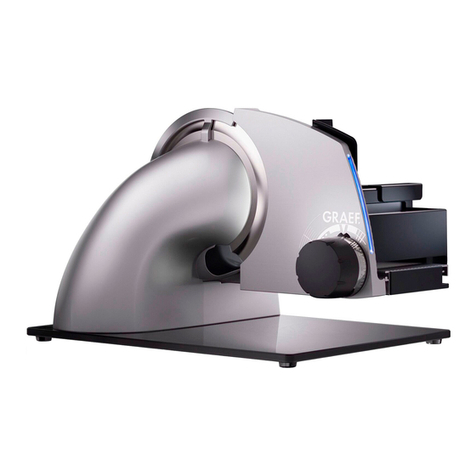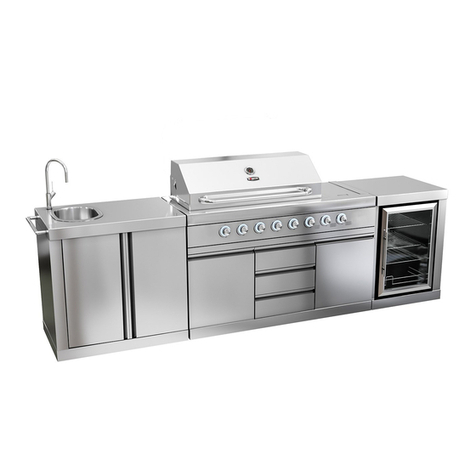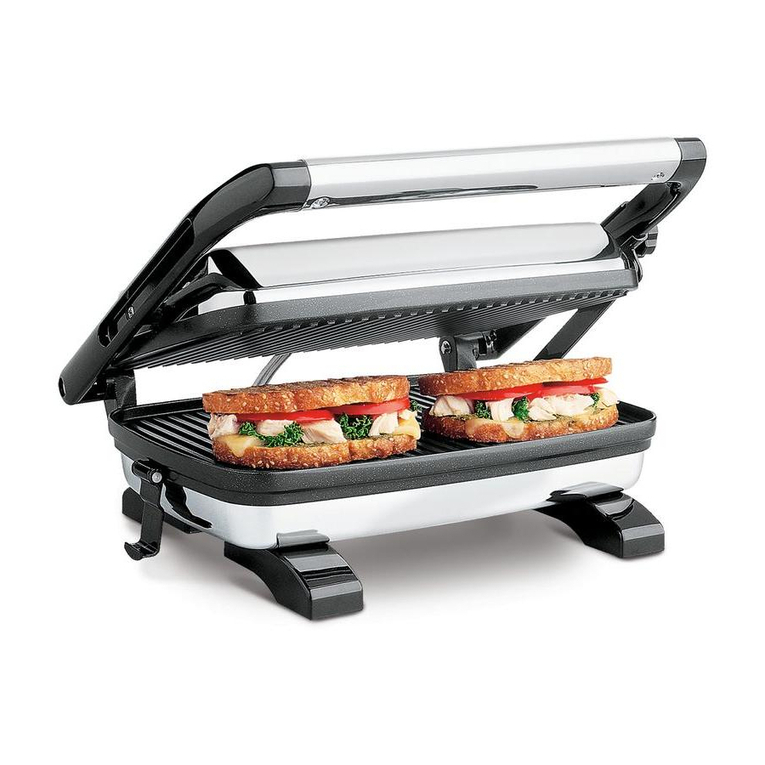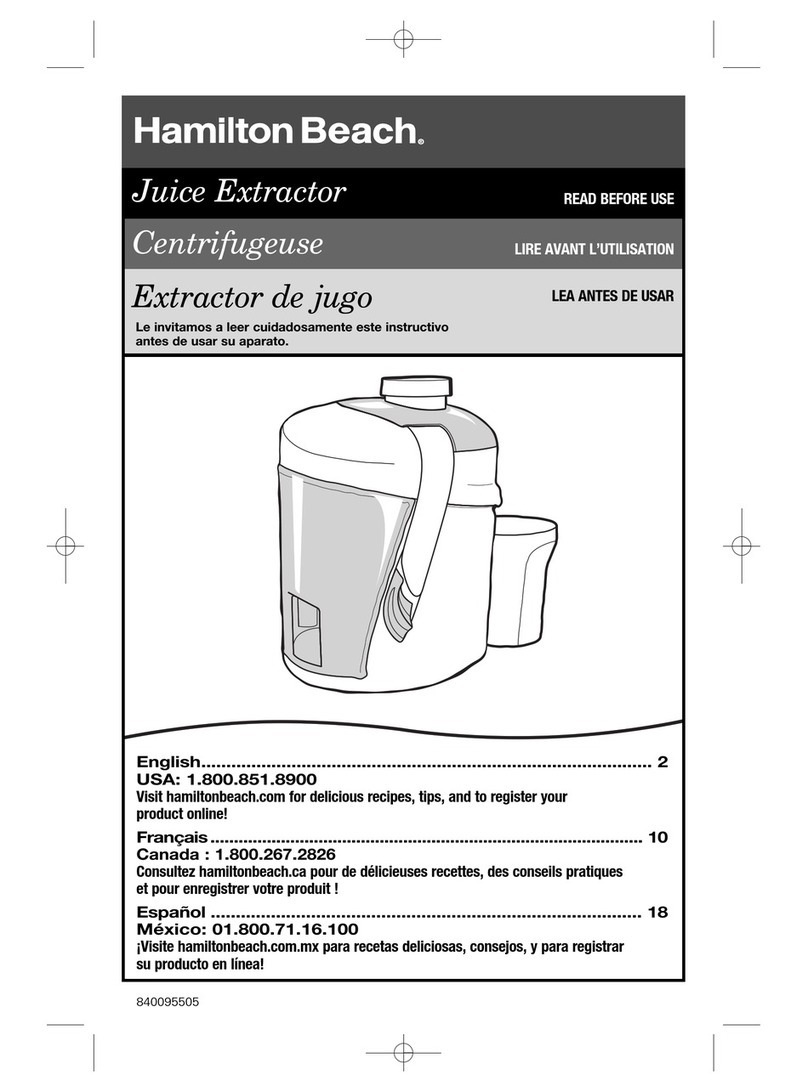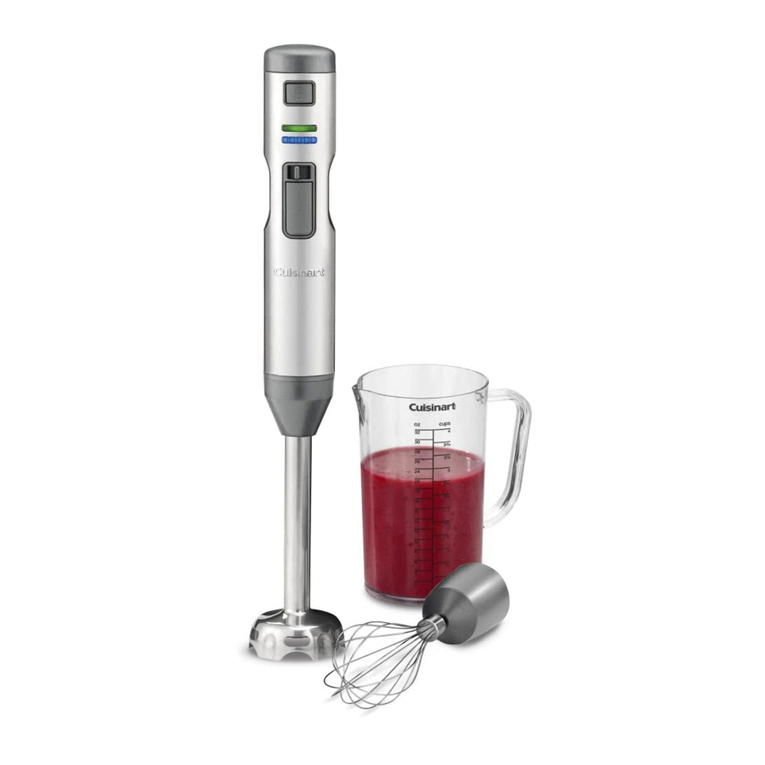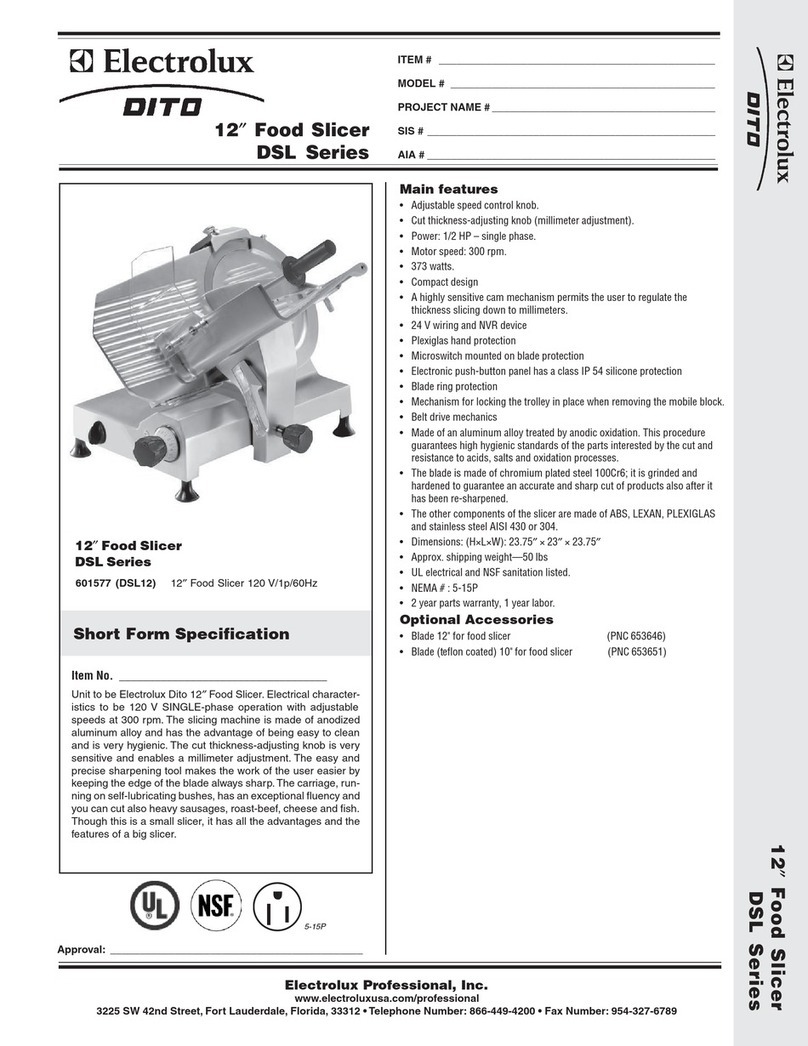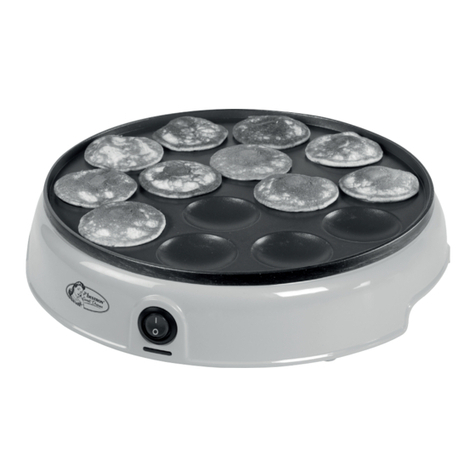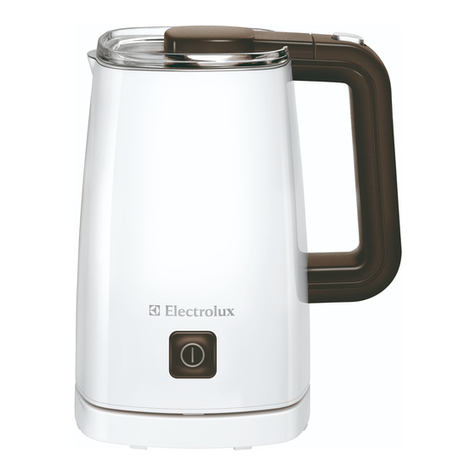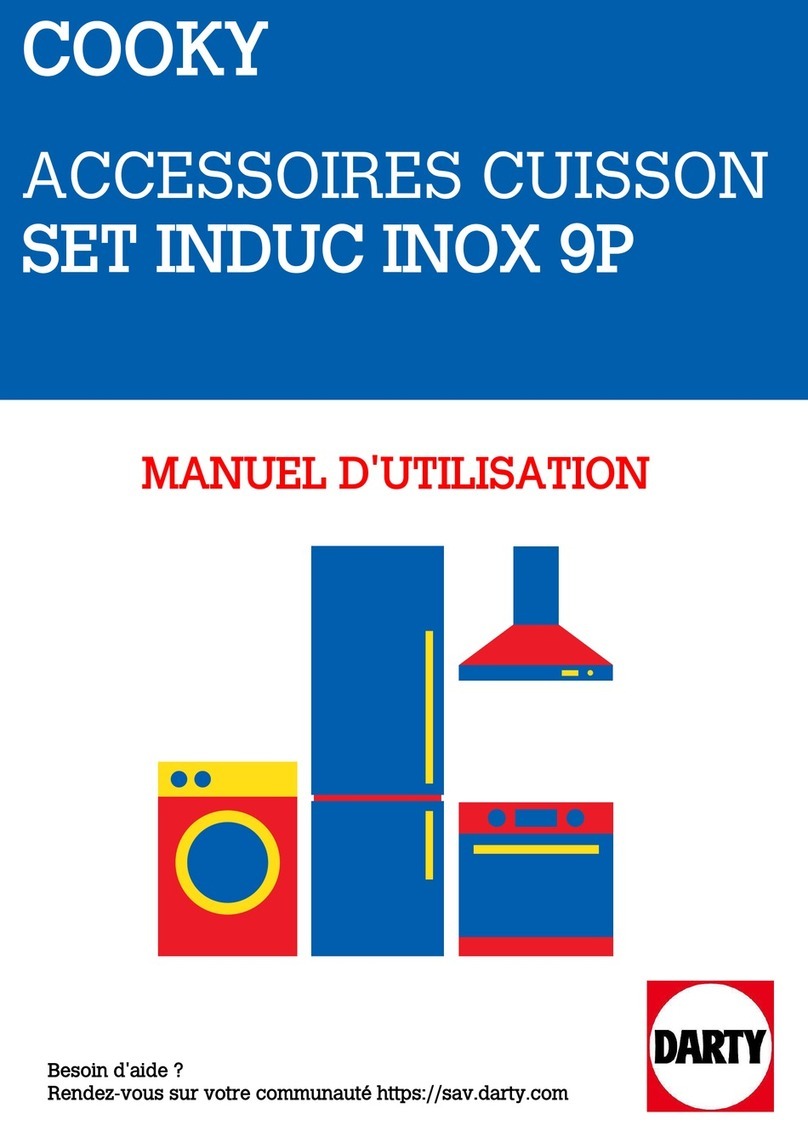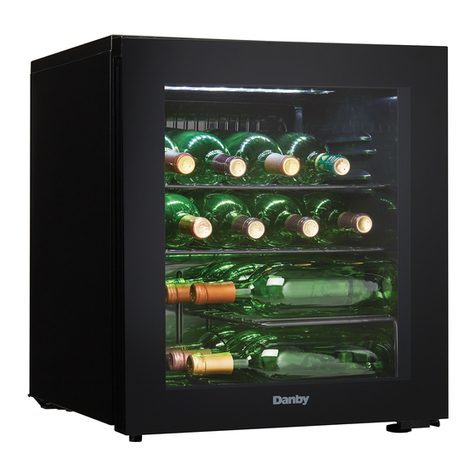Elba E K55..220 series Installation and operating instructions

Made in Italy
HOME APPLIANCES
10 0%
ELBA QUALITY
MADE IN ITALY
COOKERS
Instructions for the use - Installation advices

2
Dear Customer,
Thank you for having purchased and given your preference to
our product.
The safety precautions and recommendations reported below
are for your own safety and that of others. They will also provide
a means by which to make full use of the features offered by your
appliance.
Please preserve this booklet carefully. It may be useful in futu-
re, either to yourself or to others in the event that doubts should
arise relating to its operation.
This appliance must be used only for the task it has explicit-
ly been designed for, that is for cooking foodstuffs. Any other
form of usage is to be considered as inappropriate and there-
fore dangerous.
The manufacturer declines all responsibility in the event of
damage caused by improper, incorrect or illogical use of the
appliance.
Read the instructions carefully before installing and using the appliance.
CAUTION: this apparatus must only be installed in a permanently ventilated room in
compliance with the applicable regulations.

3
IMPORTANT INSTRUCTIONS AND ADVICE FOR THE USE OF ELECTRICAL
APPLIANCES
The use of any electrical appliance requires the compliance with some basic rules,
namely:
• do not touch the appliance with wet or damp hands (or feet);
• do not use the appliance whilst in bare feet;
• donotallowtheappliancetobeoperatedbychildrenorunqualiedpersonswithout
supervision.
The manufacturer cannot be deemed responsible for damages caused by wrong or
incorrect use.
FIRST USE OF THE OVEN
It is advised to follow these instructions:
• Furnish the interior of the oven as described at chapter “Cleaning and maintenance”.
• Switch on the empty oven on max to eliminate grease from the heating elements.
• Let the oven cool down and clean the interior of the oven with a cloth soaked in
water and neutral detergent, then dry carefully.
Important:
This appliance is designed and manufactured solely for the cooking of domestic (house-
hold) food and is not suitable for any non domestic application and therefore should not
be used in a commercial environment.
This appliance guarantee will be void if the appliance is used within a non domestic
environment i.e. a semi commercial, commercial or communal environment.

4
IMPORTANT SAFEGUARDS AND
RECOMMENDATIONS
After unpacking the appliance, check to
ensure that it is not damaged and that the
oven door closes correctly. If in doubt, do
not use and consult your supplier or a pro-
fessionallyqualiedtechnician.
Packing materials (i.e. plastic bags,
polystyrene foam, nails, packing straps,
etc.) should not be left around within easy
reach of children, as these may cause se-
rious injuries.
• Do not attempt to modify the technical
characteristics of the appliance as this
may cause danger to users.
• Do not carry out any cleaning or main-
tenance operations on the appliance
without rst disconnecting it from the
electric power supply.
• If you should decide not to use this
appliance any longer (or decide to
substitute an older model), before di-
sposing of it, it is recommended that it
is made inoperative in an appropriate
manner in accordance to health and
environmental protection regulations,
ensuring in particular that all potential-
ly hazardous parts be made harmless,
especially in relation to children who
could play with unused appliances.
• After use, always ensure that the con-
trol knobs are in the “ “ (off) position.
• Do not allow young children or inrm
persons to use the appliance without
your supervision.
• During and after use of the cooker,
certain parts will become very hot. Do
not touch hot parts.
• Keep children away from the cooker
when it is in use.
• Some appliances are supplied with a
protectivelmonsteelandaluminium
parts.Thislmmustberemovedbefo-
re using the appliance.
• WARNING: When correctly installed,
your product meets all safety require-
ments laid down for this type of product
category. However special care should
be taken around the rear or the underne-
ath of the appliance as these areas are
not designed or intended to be touched
and may contain sharp or rough edges,
that may cause injury.
• Fire risk! Do not store ammable ma-
terial in the oven (or in the storage
compartment - some models only).
• Make sure that electrical cords connec-
ting other appliances in the proximity of
the cooker cannot come into contact with
the hob or become entrapped in the oven
door.
• Do not line the oven walls with alumi-
nium foil. Do not place baking trays or
the drip tray on the base of the oven
chamber.
• The manufacturer declines all liability for
injury to persons or damage to property
caused by incorrect or improper use of
the appliance.
• The various components of the appliance
are recyclable. Dispose of them in accor-
dance with the regulations in force in your
country. If the appliance is to be scrap-
ped, remove the power cord.
• Always use oven gloves when removing
the shelves and food trays from the oven
whilst hot.
• Do not hang towels, dishcloths or other
items on the cooker or its handle – as this
couldbearehazard.
• Clean the oven regularly and do not allow
fat or oils to build up in the oven base or
trays. Remove spillages as soon as they
occur.
• Do not stand on the cooker or on the
open oven door.
• Always stand back from the cooker when
opening the oven door to allow steam
and hot air to escape before removing
the food.
• This appliance is for domestic use only.

5
COOKING HOBS
1
1
3
2
3
GAS BURNERS AND ELECTRIC HOTPLATES
1. Auxiliary burner (A) 1,00 kW
2. Rapid burner (R) 3,00 kW
3. Semi-rapid burner (SR) 1,75 kW
4. Rapid electrical plate Ø 145 mm 1500 W
Fig. 1.1
1
3
2
4
Fig. 1.2
Models:
• E 5580FG-..
• E 5580FG2-..
• E K55..320
Models:
• E K55..220
• E 5410..

6
CONTROL PANELS
2
Fig. 2.1
CONTROLS DESCRIPTION
1. Rear right burner control knob
2. Front right burner control knob
3. Front left burner control knob
4. Rear left burner control knob
5. Rear left electric plate control knob
6. Gas oven/grill control knob
7. Gas burners electronic igniter control button (cooktop burners - some models only
cooktop burners and gas oven/grill)
8. Oven light/Rotisserie control button
9. Electrical plate indicator light
123486 7
123586 7
9
Fig. 2.2
Models:
• E K55..220
• E 5410..
Models:
• E 5580FG-..
• E 5580FG2-..
• E K55..320

7
USE OF COOKING HOB
3
Eachburneriscontrolledbyagastap(g.
3.1) assuring the opening and the closing
of the gas supply.
Make the knob symbols match with the in-
dicator on the control panel to obtain:
• symbol : off
• symbol : full on (nominal rate)
• symbol : reduced rate
The maximum aperture position permits ra-
pid boiling of liquids, whereas the minimum
aperture position allows slower warming of
food or maintaining boiling conditions of li-
quids.
Toreducethegasowtominimum,rotate
the knob further anti-clockwise to point the
indicatortowardsthesmallamesymbol.
Other intermediate operating adjustments
can be achieved by positioning the indica-
tor between the maximum and minimum
aperture positions, and never between the
maximum aperture and closed positions.
Caution!
The cooking hob becomes very hot
during operation.
Keep children well out of reach.
N.B. When the cooker is not being
used, set the gas knobs to their closed
positions and also close the cock val-
ve on the gas bottle or the main gas
supply line.
Fig. 3.1
Fig. 3.2

8
Fig. 3.4
CHOICE OF THE BURNER
On the control panel, near every knob, the-
re is a diagram that indicates which burner
is controlled by that knob.
The suitable burner must be chosen ac-
cording to the diameter and the capacity
used.
As an indication, the burners and the pots
must be used in the following way:
DIAMETERS OF PANS WHICH MAY BE
USED ON THE BURNERS
BURNERS MINIMUM MAXIMUM
Auxliliary 12 cm 14 cm
Semi-rapid 16 cm 24 cm
Rapid 24 cm 26 cm
do not use pans with concave or convex
bases
It is important that the diameter of the pot
be suitable to the potentiality of the burner
so as not to compromise the high output
of the burners and therefore energy waste.
A small pot on a large burner does not give
you a boiling point in a shorten amount of
time since the capacity of heat absorption
of a liquid mass depends on the volume
and the surface of the pot.
Fig. 3.3
LIGHTING THE BURNERS
To ignite the burner, the following instruc-
tions are to be followed:
1. Press in the corresponding knob and
t
urncounter-clockwise(g.3.2)
to the
full ame position marked by the
symbol(g.3.1).
2. Press the ignition button marked by
the symbol (g.3.3).
The sparks produced by the electro-
des situated next to the burner will
light the selected burner.
In the case of a mains failure light the
burner with a match or lighted taper.
3. Adjust the gas valve to the desired po-
sition.
To turn it off, turn the knob towards the
right, up to the safety click.
Ifyourlocalgassupplymakesitdifcultto
light the burner with the knob set to maxi-
mum, set the knob to minimum and repeat
the operation.

9
RAPID HOTPLATE
To switch on the rapid hotplate, turn the
knob (Fig. 3.5) onto the desired position;
the numbers 1to 6indicate the working
positions with the increase of temperature
according to the number.
Once boiling point has been reached, redu-
ce the input according to the heating inten-
sity desired, keeping in mind that the plate
will continue to heat for 5 minutes after ha-
ving been turned off.
The features of this plate, which is equip-
ped with a heat limiter, allow:
• reaching the temperature rapidly
• maximum exploitation of the input with
atbottompots
• the limitation of input in the case of un-
suitable pots.
0
6
5
4
3
2
1
PROPER USE OF THE ELECTRIC
HOTPLATE (g. 3.6)
When the pan comes to the boil, turn the
heat down to the level desired.
Remember that the hotplate will continue
toproduceheatforaboutveminutesafter
it has been turned off.
While using the electric hotplate, you must:
• avoid keeping it on without something
on it;
• avoid pouring liquids on it while it is
hot;
• use at-bottomed (electric hotplate
type) pots and pans only
• use cooking receptacles which cover
as much of the surface of the hotplate
as possible.
• to save electricity, use lids whenever
possible.
• never cook food directly on the hotpla-
te: always use a pan or suitable con-
tainer.
An indicator light located close to the knob
signals that the hotplate is operating
Fig. 3.5 Fig. 3.6
ONLY FOR MODELS WITH ELECTRIC HOTPLATE

10
Heating
Cooking
Roasting-frying
1
2
3
4
5
6
TYPE OF COOKING
Switched OFF
For melting operations
(butter, chocolate).
To maintain food hot and to
heat small quantities of
liquid (sauces, eggs).
To heat bigger quantities; to
whip creams and sauces.
(vegetables, fruits, soups).
Slow boiling, i.e.: boiled
meats, spaghetti, soups,
continuations of steam,
cooking of roasts, stews,
potatoes.
For every kind of frying,
cutlets, uncovered cooking,
i.e.: risotto.
Browning of meats, roasted
potatoes, fried sh, omelet-
tes, and for boiling large
quantities of water.
Fast frying, grilled steaks,
etc.
0
Position
of switch
1
2
3
2
3
4
4
4
5
6
ELECTRIC HOTPLATE
USAGE TABLE
After a short period of use, experience will
teach you which setting is the right one for
your needs.
Fig. 3.7

11
USE OF THE GAS OVEN
4
The glass on the oven door reaches
high temperatures during operation.
Keep children away.
The cooker lid must be kept open when
the gas oven or grill is in use.
Fig. 4.1
9
10
6
7
8
3
4
5
1
2
GENERAL FEATURES
The oven is furnished completely clean;
itisadvisable,however,uponrstuse,to
turn the oven on to the maximum tempera-
ture to eliminate possible traces of grease
from the oven burner.
The same operation should be followed for
grill burner.
The gas oven is provided:
• One gas burner (wattage: 3,20 kW)
located at the bottom (only for the mo-
dels E K55..220, E K55..320: providing
safety device and electric ignition).
• One gas grill (wattage: 2,00 kW), pla-
ced on the top (only for the models E
K55..220, E K55..320: providing safety
device and electric ignition).
WARNING:
The door is hot, use the handle.
During use the appliance becomes hot.
Care should be taken to avoid touching
heating elements inside the oven.
OVEN BURNER
It carries out normal “oven cooking”.
Thegasowtotheburnerisregulatedby
a thermostat which allow to maintain the
oven temperature constant.
The control of the temperature is assured
by a thermostatic probe positioned inside
the oven.
The probe must be always kept in its hou-
sing, in a clean condition, as an incorrect
position or encrustment may cause an al-
teration in the control of the temperature.
The numbers 1to 10 printed on the knob
indicate the increasing oven temperature
value (see table 4.5).
To regulate the temperature, make the
chosennumberoftheknob(g.4.1)match
with the indicator on the control panel.
Only for the models E K55..220,
E K55..320:
the gas thermostat control-
ling the gas supply to the burner is equip-
ped with a safety device which automati-
cally stops the gas ow in case of ame
extinction.

12
IGNITION OF THE OVEN BURNER
Models E 5410.., E 5580FG-..,
E 5580FG2-..
To ignite the oven burner:
1. Open the oven door to the full
extent. WARNING: Risk of explo-
sion! The oven door must be open
during this operation.
2. Approachaametohole“A”(g.4.2).
3. Press in the oven control knob and
turn counter-clockwise to position 10
(gs.4.1,4.3).
Never continue this operation for
more than 15 seconds. If the burner
has still not ignited, wait for about
1 minute prior to repeating the igni-
tion.
4. Gently close the oven door and set the
oven control knob to the required tem-
perature.
Fig. 4.3
A
Models E K55..320, E K55..220
To ignite the oven burner:
1. Open the oven door to the full
extent. WARNING: Risk of explo-
sion! The oven door must be open
during this operation.
2. Press the button marked with a star
symbol(g.4.4)andkeeppressedun-
til the oven burner ignites. Press in the
oven control knob and turn counter-
clockwise to position 10 (gs. 4.1,
4.3). Keep the knob pressed. To light
the oven burner manually, approach a
ametothehole‘A’oftheovenoor
(g.4.2).
3. Never continue this operation for more
than 15 seconds. If the burner has still
not ignited, wait for about 1 minute pri-
or to repeating the ignition.
4. After lighting the burner, wait a few se-
conds before releasing the knob (until
the safety valve stays open).
5. Gently close the oven door and set the
oven control knob to the required tem-
perature.
Fig. 4.2
ATTENTION: Never turn the gas ther-
mostat before approaching a ame to
the hole “A” of the oor.
WARNING: Risk of explosion! The
oven door must be open during this
operation.
ATTENTION: Never turn the gas ther-
mostat before approaching a ame to
the hole “A” of the oor.
WARNING: Risk of explosion! The
oven door must be open during this
operation.

13
For efcient oven preheating, we re-
commend that grill tray and rack are
removed from the oven and replaced
after about 15 minutes.
THERMOSTAT
POSITION DISHES
1 Heating of foods
1Meringue - Fruit pies
Cooked fruit
1 - 2 Cakes - Amaretti
Vegetables
2 - 3 Lasagna - Cakes
3 - 4 Roast veal - Pie crusts
5 - 6 Wild game - Birds
Smallsh-Roastpork
6 - 7 Largesh-Roastbeef
7 - 8 Pizza - Red meats
8 - 9 Toasted sandwiches
10 Oven cleaning
OVEN COOKING
To cook, before introducing the food, prehe-
at the oven to the desired temperature.
When the oven has reached the desired
temperature, introduce the food, control
the cooking time and turn off the oven 5
minutes before the theoretical time to recu-
perate the stored heat.
COOKING EXAMPLES
Temperatures are approximate as they
vary depending on the quality and amount
of food.
Remember to use ovenproof dishes and
to adjust the oven temperature during co-
oking if necessary.
Table 4.5
Models E K55..320, E K55..220
If the ame extinguishes for any reason,
the safety valve will automatically shut off
the gas supply to the burner.
To re-light the burner, rst turn the oven
control knob to position , wait for at le-
ast 1 minute and then repeat the lighting
procedure.
Fig. 4.4

14
Fig. 4.7
Fig. 4.6
IGNITION OF THE GRILL BURNER
(Models E 5410.., E 5580FG-..,
E 5580FG2-..)
To ignite the grill burner:
1. Open the oven door to the full
extent. WARNING: Risk of explo-
sion! The oven door must be open
during this operation.
2. Applya ame topipe of thegrill bur-
ner,asshowning.4.6.
3. Press in the oven control knob and
turn clockwise to the position marked
by the symbol (gs.4.1,4.7).
Never continue this operation for
more than 15 seconds. If the burner
has still not ignited, wait for about
1 minute prior to repeating the igni-
tion.
4. Do not close completely the oven door.
The grill must always be used with the
oven door slightly open and with shield
“A”mounted(Fig.4.9).Seespecicin-
structionsinthesection‘USEOFTHE
GRILL’.
ATTENTION: Never turn the gas ther-
mostat before approaching a ame to
the pipe of the burner.
WARNING: Risk of explosion! The
oven door must be open during this
operation.
IGNITION OF THE GRILL BURNER
(Models E K55..220, E K55..320)
To ignite the grill burner:
1. Open the oven door to the full
extent. WARNING: Risk of explo-
sion! The oven door must be open
during this operation.
2. Press the button marked with a star
symbol (g. 4.4) and keep pressed
until the grill ignites. Press in the oven
control knob and turn clockwise to the
position marked by the symbol
(gs. 4.1, 4.7). Keep the knob pres-
sed. In case of mains failure, press the
knobrmlyandputalitmatchortaper
tothepipeoftheburner(g.4.6).
3. Never continue this operation for more
than 15 seconds. If the burner has still
not ignited, wait for about 1 minute pri-
or to repeating the ignition.
4. After lighting the burner, wait a few se-
conds before releasing the knob (until
the safety valve stays open).
Do not close completely the oven door.
The grill must always be used with the
oven door slightly open and with shield
“A”mounted(Fig.4.9).Seespecicin-
structionsinthesection‘USEOFTHE
GRILL’
If the ame extinguishes for any reason,
the safety valve will automatically shut off
the gas supply to the burner.
To re-light the burner, rst turn the oven
control knob to position , wait for at le-
ast 1 minute and then repeat the lighting
procedure.

15
OVEN LIGHT
The oven is equipped with a light that illu-
minates the oven to enable visually control-
ling the food that is cooking.
This light is controlled by a switch on the
controlpanel(g.4.8)
USE OF THE GRILL
Very important: the grill must always be
used with the oven door slightly open
and with shield “A” mounted (Fig. 4.9)
The oven door becomes very hot during
operation. Keep children away.
Mount shield “A” which permits to protect the
control panel from the heat.
Turn on the grill, as explained in the prece-
ding paragraphs and let the oven preheat for
about 5 minutes with the door slightly open.
Introduce the food to be cooked, positioning
the rack as close to the grill as possible.
The dripping pan should be placed under the
rack to catch the cooking juices and fats.
Note: It is recommended that you do not
grill for longer than 30 minutes at any
one time.
ROTISSERIE
The oven is equipped with a rotisserie for
cooking on the spit using the grill.
This device is made up of:
• an electrical motor mounted on the
rear part of the oven;
• a stainless steel rod, equipped with a
detachable athermic grip and 2 recor-
dable forks;
• a rod support to be inserted into the
central rack holders of the oven.
The rotisserie motor is operated by the
switch indicated by the symbol on
thecontrolpanel(g.4.8).
USE OF THE ROTISSERIE
Very important: the rotisserie must
always be used with the oven door
slightly open and with shield “A”
mounted (Fig. 4.9).
• Insert the dripping pan into the lowest
rack holders of the oven and insert the
rod support into the intermediate rack
holders.
• Put the meat to be cooked onto the
rod, being careful to secure it in the
center with the special forks.
• Insert the rod into the motor opening
and rest it onto the support of the spit
collar; then remove the grip by turning
it to the left.
The rotation direction of the rotisserie can
be either clockwise or counter-clockwise.
A
ATTENTION: Hot part.
Allow to cool before
removing.
Fig. 4.9
Fig. 4.8
Fig. 4.10

16
ADVICE FOR THE CONSUMER
5
GENERAL ADVICE
• Important: before any operation of
cleaning and maintenance discon-
nect the appliance from the electri-
cal network.
• When the appliance is not being used,
it is advisable to keep the gas tap clo-
sed.
• Every now and then check to make
sure that the exible tube that con-
nects the gas line or the gas cylinder
to the appliance is in perfect condition
and eventually substitute it if it shows
signs of wearing or damage.
• The periodical lubrication of the gas
taps must be done only by specialized
personnel.
• If a tap becomes stiff, do not force;
contact your local Service Centre.
• Do not use cleaning products with a
chlorine or acidic base.
WARNING
When correctly installed, your product
meets all safety requirements laid down
for this type of product category. Ho-
wever special care should be taken
around the rear or the underneath of the
appliance as these areas are not desig-
ned or intended to be touched and may
contain sharp or rough edges, that may
cause injury.
Attention
The appliance gets very hot, mainly around the cooking areas. It is very important
that children are not left alone in the kitchen when you are cooking.
Do not use a steam cleaner because the moisture can get into the appliance thus
make it unsafe.
Do not use harsh abrasive cleaners or sharp metal scrapers to clean the oven door
glass or the glass lid (models with glass lid only) since they can scratch the surfa-
ce, which may result in shattering of the glass.
ENAMELLED PARTS
All the enamelled parts must be cleaned
with a sponge and soapy water or other
non-abrasive products.
Dry preferably with a microbre or soft
cloth.
Acidic substances like lemon juice, tomato
sauce, vinegar etc. can damage the ena-
mel if left too long.
STAINLESS STEEL, ALUMINIUM
PARTS AND SILK-SCREEN PRIN-
TED SURFACES
Clean using an appropriate product.
Always dry thoroughly.
IMPORTANT: these parts must be cleaned
very carefully to avoid scratching and abra-
sion. You are advised to use a soft cloth
and neutral soap.
CAUTION: Do not use abrasive substan-
ces or non-neutral detergents as these
will irreparably damage the surface.
HOT PLATE
Foods burned on the hot plates must al-
ways be cleaned dry.
Do not use water to avoid the forming of
rust.
After its use, pour a bit of oil onto the warm
plate and rub with a cloth.

17
BURNERS
They can be removed and washed with so-
apy water only.
They will remain always perfect if cleaned
with products used for silverware.
After cleaning or wash, check that burner-
caps and burner-heads are dry before pla-
cing them in the respective housings.
Check that the electrode S(g.5.1)isal-
ways clean to ensure trouble-free spar-
king.
Note:
The electrode “S” must be very carefully
cleaned. To avoid damage to the electric
ignition do not use it when the burners
are not in place.
CORRECT REPLACEMENT OF THE
BURNERS
It is very important to check that the bur-
ner ame distributor “F” and the cap “C”
hasbeencorrectlypositioned(seegs.5.1-
5.2) - failure to do so can cause serious
problems.
Fig. 5.1 Fig. 5.2
INSIDE OF OVEN
The oven should always be cleaned after
use when it has cooled down.
The cavity should be cleaned using a mild
detergent solution and warm water. Suita-
ble proprietary chemical cleaners may be
used after rst consulting with the manu-
facturers recommendations and testing a
small sample of the oven cavity. Abrasive
cleaning agents or scouring pads/cloths
should not be used on the cavity surface.
NOTE: The manufacturers of this applian-
ce will accept no responsibility for damage
caused by chemical or abrasive cleaning.
Fire risk! Donotstoreammablematerial
in the oven.
Let the oven cool down and pay special
attention no to touch the hot heating
elements inside the oven cavity.
GAS TAPS
In the event of operating faults in the gas
taps, call the Service Department.
S
F
C

18
GLASS LID (models with glass lid)
For cleaning purposes, the lid can be ea-
sily removed upwards once taken to the
upright position.
Should the hinges slip off, replace them in
their housing being careful that:
• The right housing must receive the
hinge marked “D” while the left hou-
sing must receive the hinge marked
“S” (Fig. 5.3)
REGULATING OF THE BALANCE
Lower the lid and check the correct balan-
ce.
While opened at 45° it should hang up.
If necessary, register the calibration of the
hinge springs using the screws “R” (g.
5.3).
SUBSTITUTION OF THE OVEN
LIGHT
WARNING: Ensure the appliance is
switched off before replacing the lamp to
avoid the possibility of electric shock.
• Let the oven cavity and the heating
elements to cool down.
• Switch off the electrical supply.
• Remove the protective cover.
• Unscrew and replace the bulb with a
new one suitable for high temperatu-
res (300°C) having the following speci-
cations:220V,E14andsamepower
(check watt power as stamped in the
bulb itself) of the replaced bulb
• Rettheprotectivecover.
Note: Oven bulb replacement is not cove-
red by your guarantee.
OVEN DOOR (some models only)
The internal glass of the oven door can be
easily removed for cleaning by unscrewing
thetwoxingscrews(g.5.4).
S
D
R
Do not shut lid when
burner alight.
ATTENTION
Do not lower the glass lid when the
gas burner or electrical plates are
still hot or when the oven is
working or still hot.
Do not lay on the glass lid hot pans
and heavy kitchen utensils.
Dry off any liquid whitch may have
spilt on the cover before opening it.
Models with glass lid
Fig. 5.3
Fig. 5.4

19
Advice for the
installer
IMPORTANT
• Cooker installation must only be carried out by QUALIFIED TECHNICIANS and in
compliance with local safety standards.
• The appliance must be installed in compliance with regulations in force in your country
and in observation of the manufacturer’s instructions.
• This appliance is not connected to a device to evacuate the combustion products. This
must be installed and connected in conformity with the installation rules in force. Pay
special care to room ventilation as well.
• Always disconnect the appliance from the electrical supply before carrying out any
maintenance operations or repairs.
• The surfaces of adjacent furniture and walls must be capable of withstanding tempe-
ratures in excess of 75°C.
• Some appliances are supplied with a protective lm on steel and aluminium parts.
This lm must be removed before using the cooker.

20
INSTALLATION
6
INSTALLATION
Thecookersaffordclass‘1’protectionagainstoverheatingofsurroundingsurfaces.
A space of at least 2 cm must be left between the cooker and any adjacent furniture, which
mustnotexceedtheheightofthecooktop(g.6.1).
If the cooker is installed adjacent to furniture which is higher than the gas hob cooktop, a
gap of at least 30 cm must be left between the side of the cooker and the furniture.
If the cooker is located on a pedestal, provide safety measures to prevent it falling out.
The walls of the units must not be higher than work top and must be capable of resi-
sting temperatures of 75 °C above room temperature.
Do not instal the appliance near inammable materials (eg. curtains)
50 cm
50 cm
450 mm
650 mm
300 mm
20 mm
20 mm
500 mm
Fig. 6.1 Fig. 6.2
This manual suits for next models
4
Table of contents
Other Elba Kitchen Appliance manuals
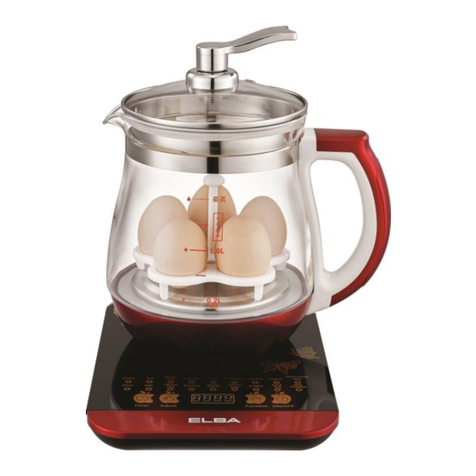
Elba
Elba EHP-G1583G(RD) User manual
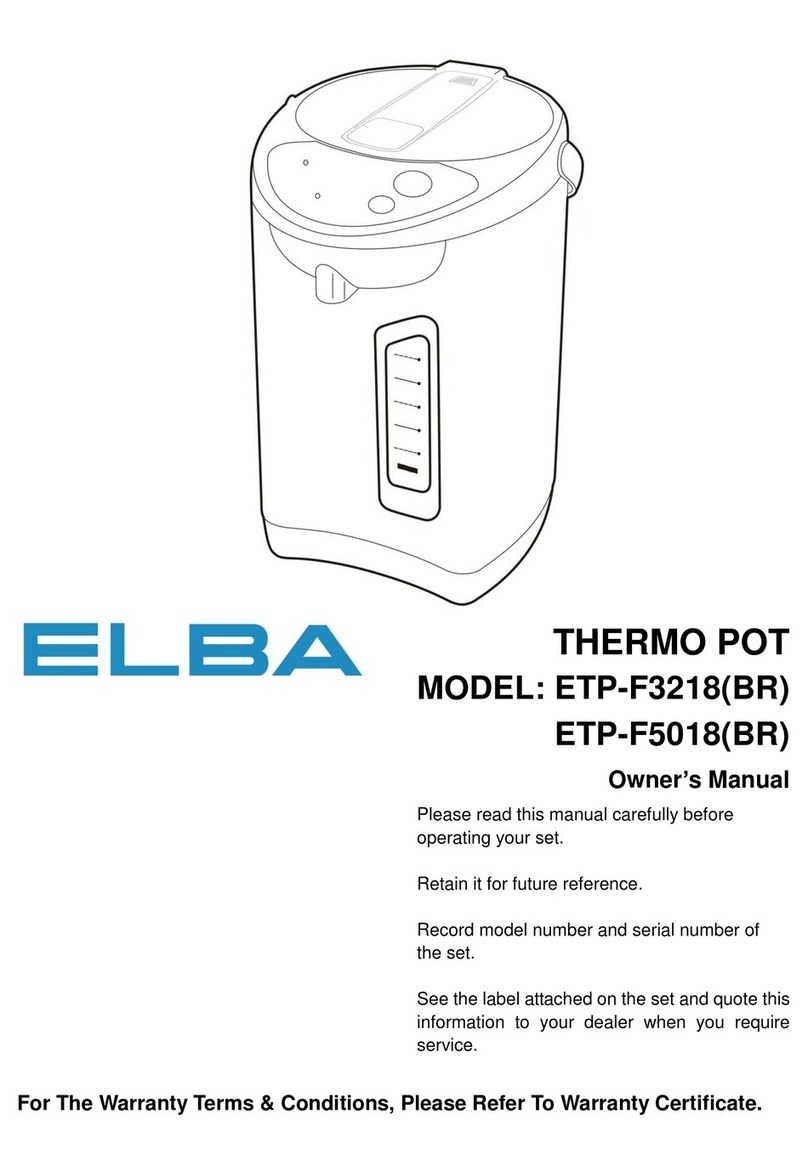
Elba
Elba ETP-F3218 User manual
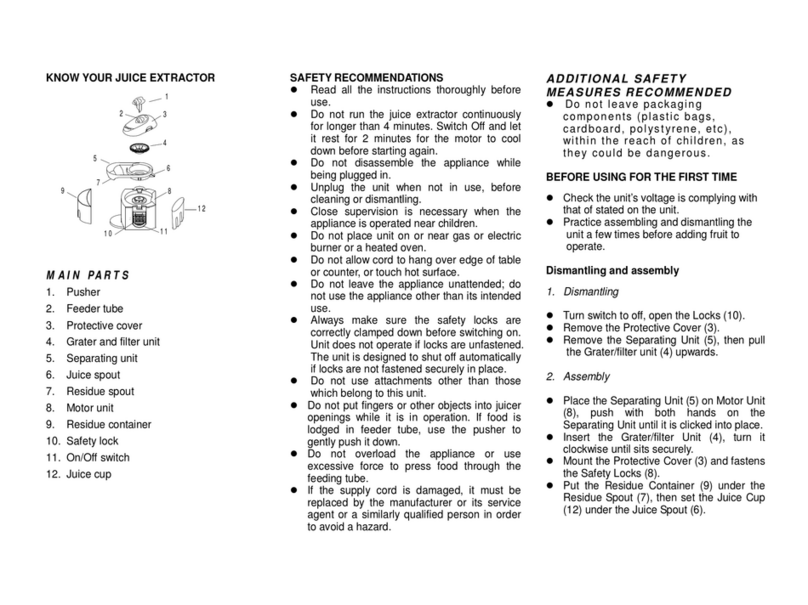
Elba
Elba EJE-1302 User manual
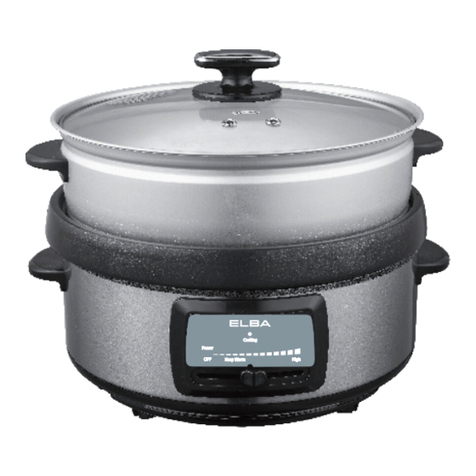
Elba
Elba EMC-F4316 User manual

Elba
Elba EMC-N5017 User manual
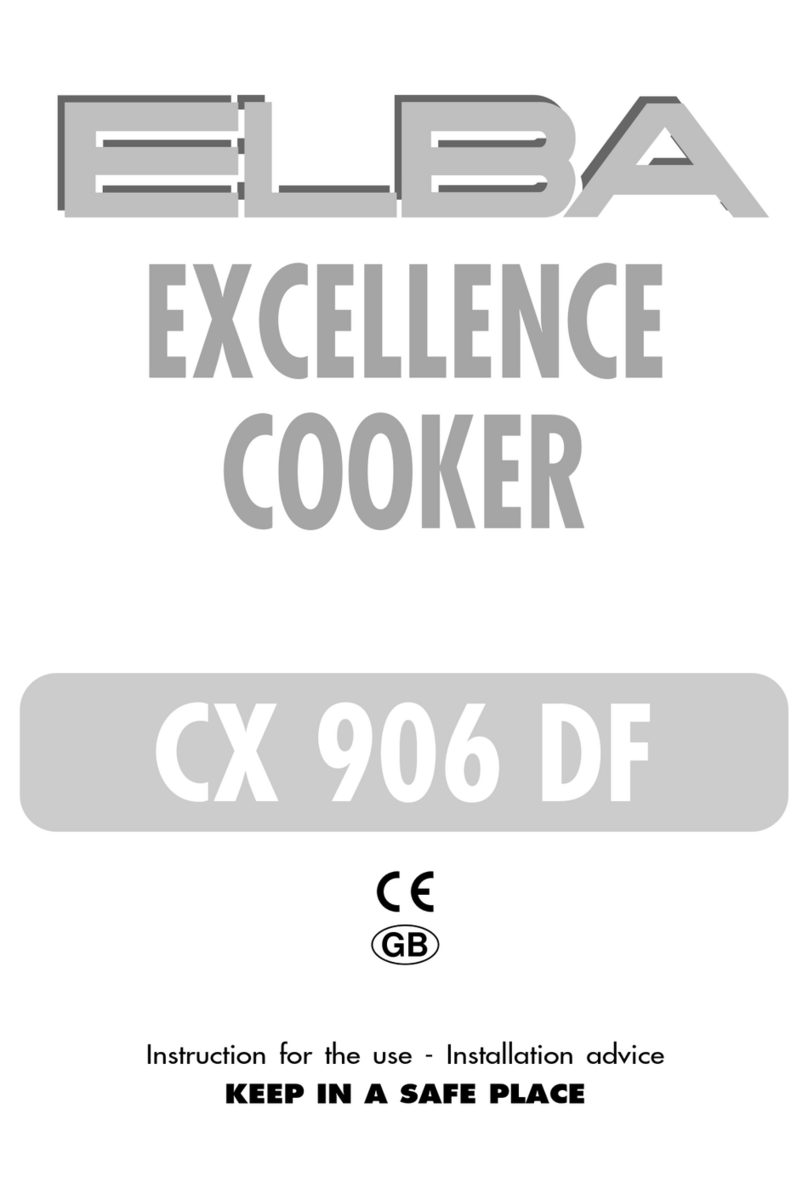
Elba
Elba CX 906 DF Technical manual
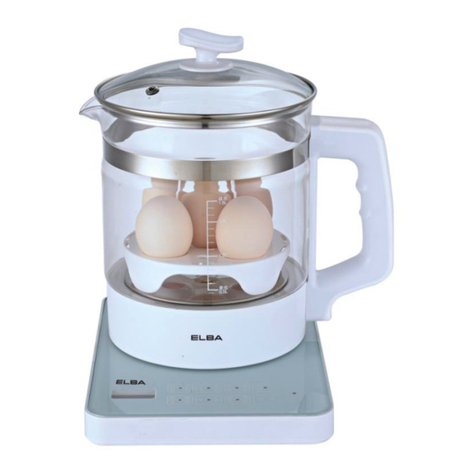
Elba
Elba EHP-E1881G User manual
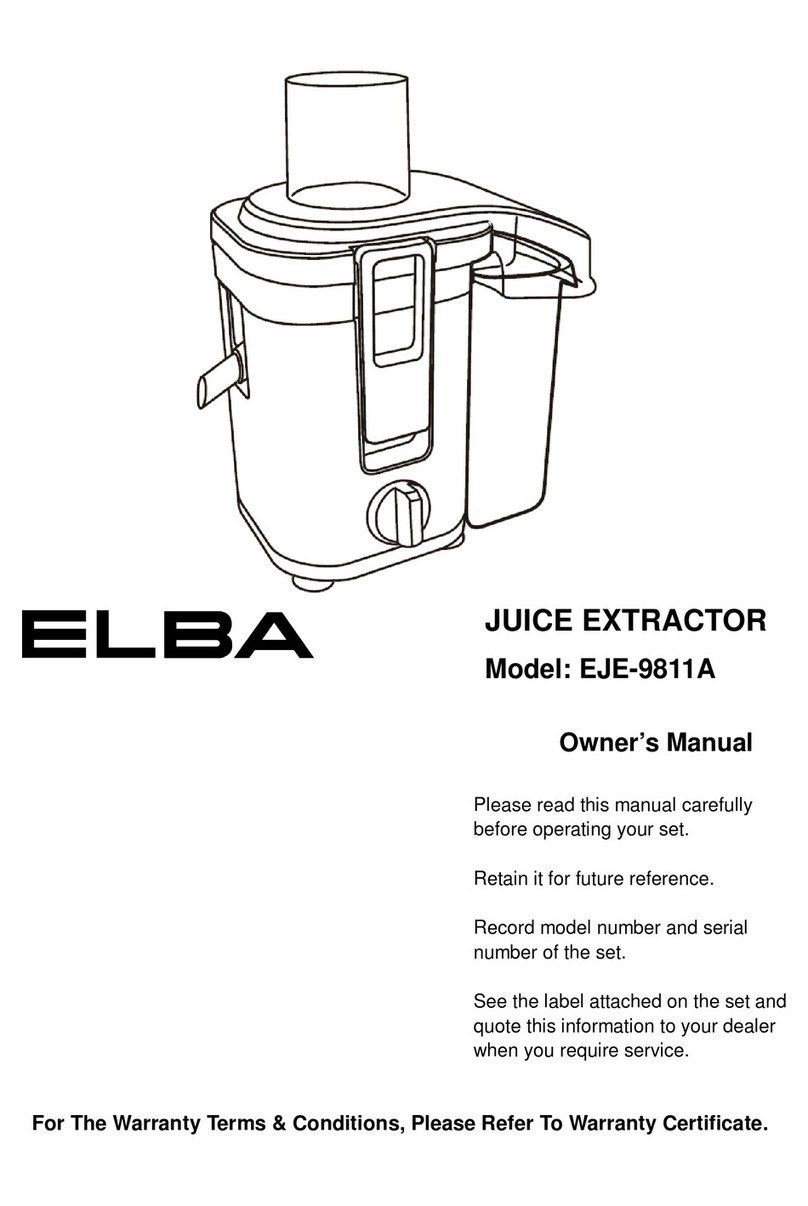
Elba
Elba EJE-9811A User manual
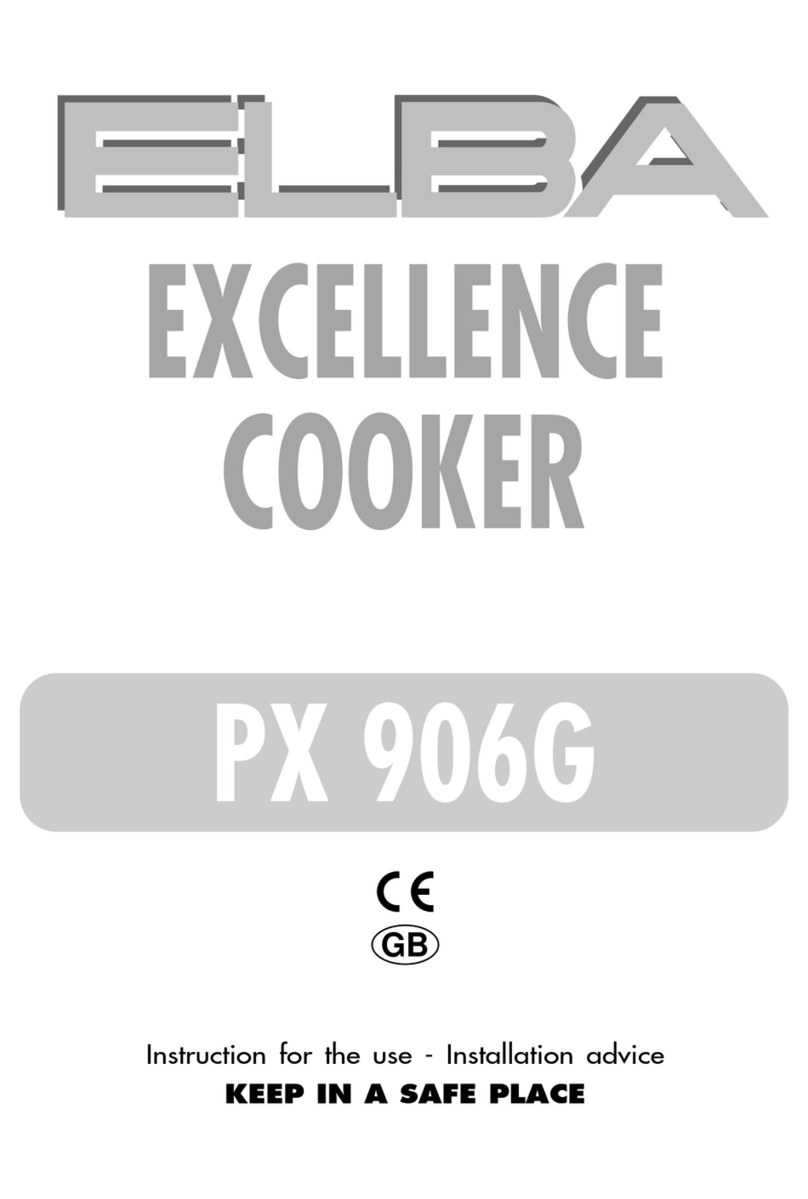
Elba
Elba PX 906G Installation and operating instructions
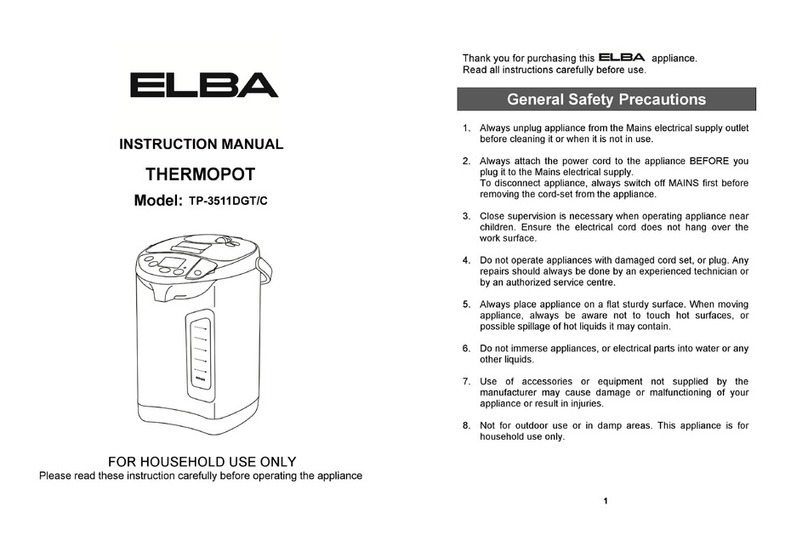
Elba
Elba TP-3511DGT User manual
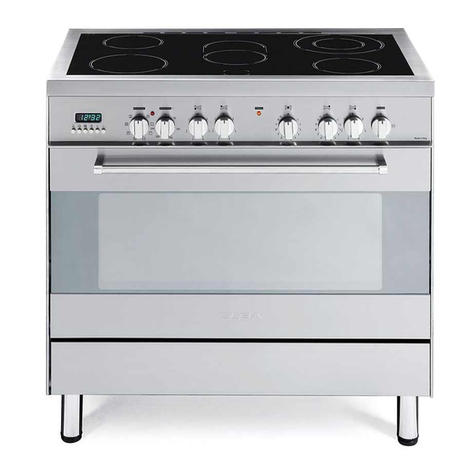
Elba
Elba N96 EX 939 S Technical manual
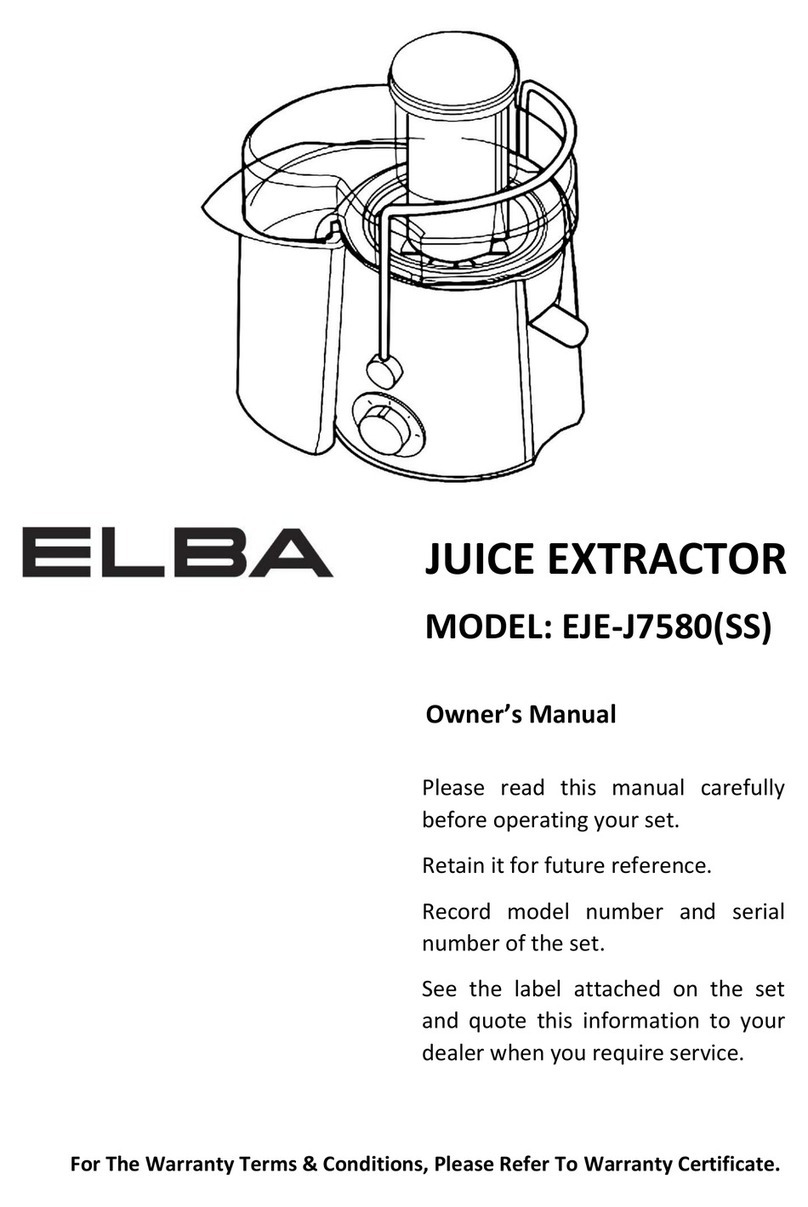
Elba
Elba EJE-J7580(SS) User manual
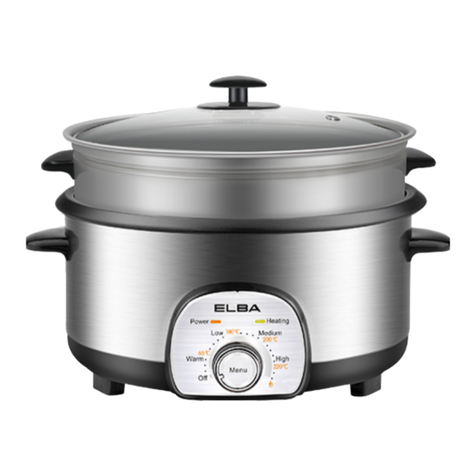
Elba
Elba EMC-K5010 User manual
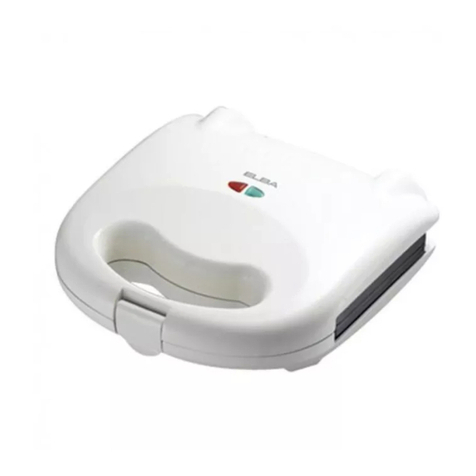
Elba
Elba ESM-2085 User manual
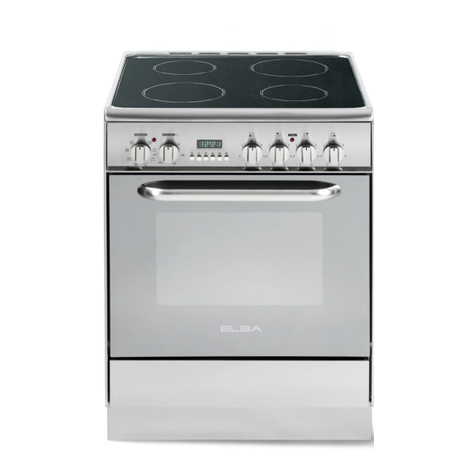
Elba
Elba S 66 X 938 User manual

Elba
Elba EMC-N9015 User manual
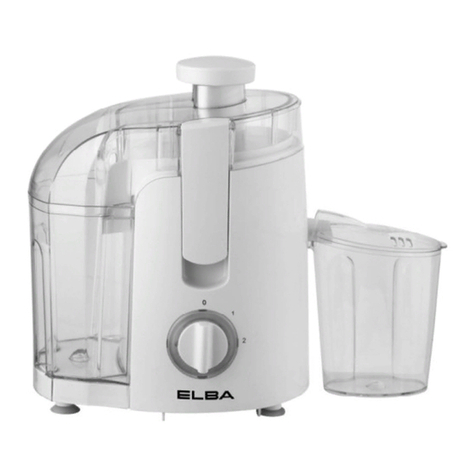
Elba
Elba EJE-A0435 User manual
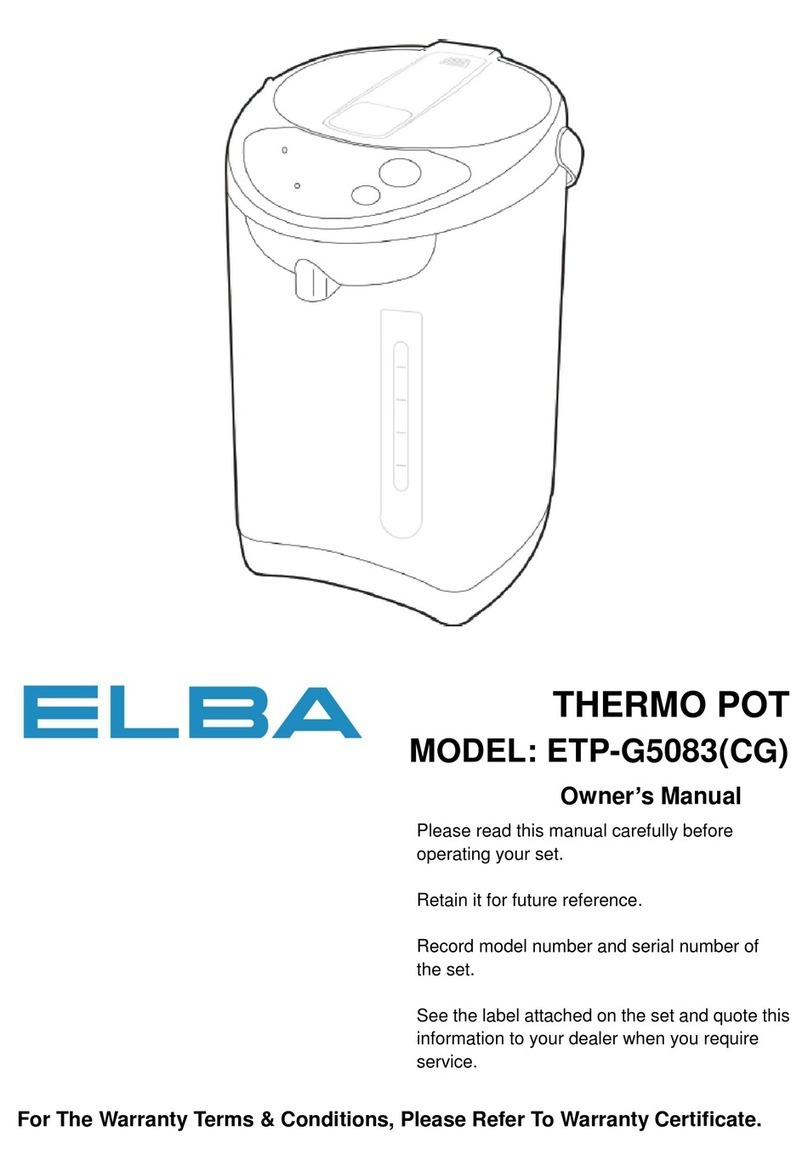
Elba
Elba ETP-G5083(CG) User manual

Elba
Elba EEC 563 series User manual
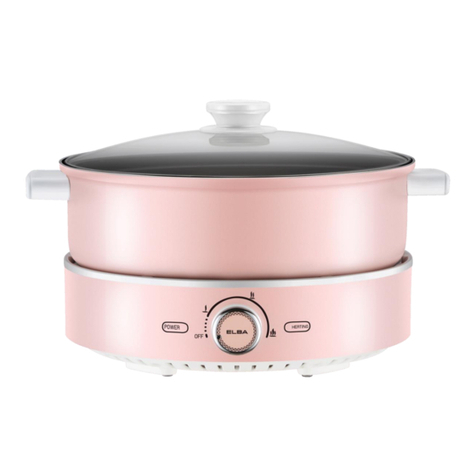
Elba
Elba EMC-K5015PK User manual

